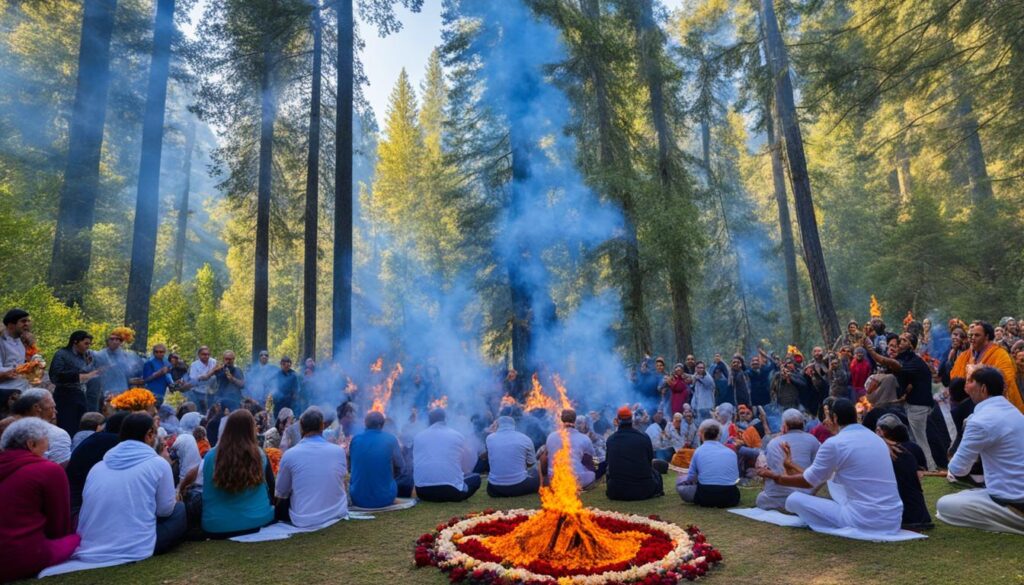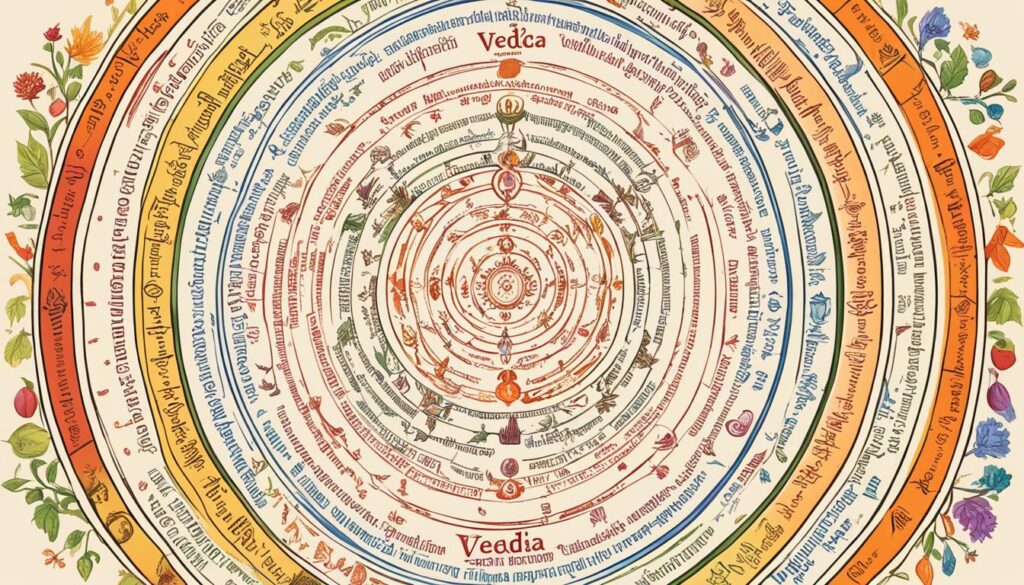What if there was a spiritual tradition that held timeless wisdom, ancient rituals, and profound insights into the nature of the Divine? A tradition that has shaped the beliefs and practices of Hinduism, one of the world’s largest religions? Welcome to the world of Vedic religion, a sacred path that continues to inspire and guide countless seekers even in the modern age.
Key Takeaways:
- The Vedas, ancient sacred texts of the Vedic religion, are among the oldest scriptures in the world.
- Vedic religion is not limited to one particular God or idea but explores the nature of the Divine in its entirety.
- The Vedas are divided into four parts: Samhitas, Brahmanas, Aranyakas, and Upanishads, each containing different aspects of spiritual wisdom and knowledge.
- Vedic religion laid the foundation for Hinduism and continues to influence its beliefs and practices.
- Exploring the essence of Vedic religion can offer profound insights into Indian spirituality and enrich our contemporary lives.
The Vedas: Ancient Wisdom and Knowledge
The Vedas, the ancient texts of the Vedic religion, are not just a compilation of hymns and prayers. They are eternal scriptures that delve deep into the cause, function, and response of human existence. With profound insights, the Vedas explore the very fabric of life, addressing existential questions and offering timeless wisdom.
These sacred scriptures describe the creation, preservation, and dissolution of the universe, unraveling the mysteries of cosmic forces and natural phenomena. They also delve into the intricate details of the evolution, destiny, bondage, and freedom of the soul. Through their profound teachings, the Vedas bridge the gap between the supersensuous dimension and everyday consciousness, providing answers to the challenges and dilemmas of human existence.
Immerse yourself in the wisdom of the Vedas and uncover the hidden treasures of ancient knowledge that continue to resonate with significance in the modern world. Discover the profound insights, rituals, and practices that form the foundation of Vedic culture and traditions.

The Essence of Vedic Religion
- Vedic religion encompasses a wide range of beliefs, practices, and rituals that shape the lives of its adherents.
- These traditions have been passed down through generations, preserving the wisdom of the ancient Vedic texts.
- Vedic rituals and ceremonies are deeply rooted in the belief that they connect individuals with the cosmic forces and divine energies.
- Vedic culture thrives on the principles of harmony, reverence for nature, and the pursuit of spiritual enlightenment.
Explore the rich tapestry of Vedic religion, delve into the ancient Vedic texts, and uncover the enduring traditions that continue to inspire millions around the world. Open your mind and heart to the profound wisdom of the Vedas and embrace the timeless teachings that hold the key to a deeper understanding of the human experience.
The Contents and Types of the Vedas
When exploring the vast universe of Vedic religion, it is essential to understand the contents and types of the ancient Vedic texts. The Vedas, considered the foundation of Hinduism, are divided into four distinct parts:
1. Samhitas
The Samhitas are the oldest known part of the Vedas and consist of hymns and prayers. These texts are revered for their poetic and spiritual significance, expressing devotion to various deities and capturing the essence of Vedic culture and beliefs.
2. Brahmanas
The Brahmanas are handbooks of rituals and prayers for priests. These texts provide detailed instructions on religious ceremonies, sacrificial offerings, and the proper conduct of rituals. They are a testament to the intricate practices and traditions established in ancient Vedic society.

3. Aranyakas
The Aranyakas are concerned with worship and meditation. These texts focus on spiritual practices that bridge the gap between the external world and the inner self. They provide guidance for individuals seeking spiritual enlightenment and a deeper connection with the divine.
4. Upanishads
The Upanishads contain mystical and philosophical teachings. These profound texts explore the nature of reality, the self, and the ultimate truth. They delve into metaphysical concepts, such as the nature of consciousness and the relationship between the individual and the cosmic consciousness.
The division of the Vedas into these four parts reflects the comprehensive nature of Vedic wisdom, encompassing hymns, rituals, meditative practices, and philosophical contemplations. Together, these texts form a rich tapestry of knowledge, providing insights into ancient Vedic traditions, beliefs, and culture.
| Vedic Text | Description |
|---|---|
| Samhitas | The oldest part of the Vedas, consisting of hymns and prayers. |
| Brahmanas | Handbooks of rituals and prayers for priests. |
| Aranyakas | Concerned with worship and meditation. |
| Upanishads | Contain mystical and philosophical teachings. |
Types of Vedas: Rigveda, Samaveda, Yajurveda, Atharvaveda
The Samhita part of the Vedas can be divided into four types: Rigveda, Samaveda, Yajurveda, and Atharvaveda. Each Veda has its unique characteristics and serves a specific purpose within the Vedic tradition.
Rigveda
The Rigveda is the oldest of the four Vedas and is considered the foundation of Vedic literature. It consists of hymns and prayers dedicated to various deities, expressing gratitude, seeking blessings, and celebrating the beauty and power of the universe.
Samaveda
The Samaveda is primarily concerned with public worship and the performative aspect of Vedic rituals. It is closely intertwined with music and dance and serves as the root of Indian classical music traditions. The Samaveda interprets the hymns of the Rigveda in melodious and rhythmic forms for ceremonial chanting.
Yajurveda
The Yajurveda emphasizes rituals, mantras, and chants used during sacrifices and ceremonies to establish a connection with the Divine. It provides guidance on conducting various religious rituals and contains instructions for priests who officiate these ceremonies. The Yajurveda is a practical guide for worshiping and honoring the deities.
Atharvaveda
The Atharvaveda consists of hymns and incantations aimed at healing, protection, and overcoming obstacles. It includes magical formulae for various purposes, including medicine, exorcism, and the alleviation of diseases and ailments. The Atharvaveda explores aspects of daily life and addresses human concerns and challenges.
The division of the Vedas into different types reflects the multifaceted nature of Vedic knowledge and its applicability in various aspects of life. The Rigveda’s devotional hymns, the Samaveda’s melodic expression, the Yajurveda’s ritualistic practices, and the Atharvaveda’s practical wisdom all contribute to the comprehensive richness of Vedic culture and traditions.

Vedic Religion and Hinduism
Vedic religion, also known as Vedism, was an ancient Indian religion that coexisted with the compilation of the Vedas. It was a polytheistic system that revered various masculine deities associated with celestial phenomena and natural events. The Vedic religion served as the foundation for Hinduism, absorbing and assimilating its beliefs and practices over time. Hinduism developed from Vedic traditions, enriching them with concepts such as reincarnation, karma, and the pursuit of liberation through meditation.
While Vedic religion emphasized the worship of specific deities and adherence to rituals, Hinduism expanded to embrace a wide range of spiritual paths, accommodating diverse beliefs and practices. It evolved to encompass not only the Vedic traditions but also regional customs and spiritual philosophies. Hinduism integrated the wisdom of the Vedas with the teachings of gurus, saints, and sages, creating a comprehensive tapestry of spiritual exploration and devotion.
Central to Hinduism are the concepts of dharma (duty/righteousness) and moksha (liberation from the cycle of birth and death). Through adherence to dharma and the pursuit of self-realization, individuals seek to live aligned with cosmic principles and transcend the cycles of suffering and rebirth. Hinduism offers various paths to moksha, including the paths of knowledge (jnana yoga), devotion (bhakti yoga), meditation (dhyana yoga), and selfless action (karma yoga).
As the Vedic texts continue to be revered and studied within Hinduism, the influence of Vedic religion remains alive. Many rituals, mantras, and hymns from the Vedas are still performed and recited in Hindu ceremonies and practices. Vedic rituals, such as yajnas (fire sacrifices), are considered sacred and continue to be carried out by priests in temples and homes.

The Influence of Vedic Religion on Hinduism
Vedic religion has played a pivotal role in shaping the development of Hinduism. Many of the rituals and practices that are an integral part of modern Hinduism can be traced back to the Vedic traditions. The Vedic texts provided the foundation for the philosophical concepts that form the core of Hindu belief.
One of the significant contributions of Vedic religion to Hinduism is the concept of atman and Brahman. The Vedas introduced the idea of the eternal soul (atman) and the ultimate reality (Brahman) that underlies all existence. These profound concepts continue to define the philosophical framework of Hindu thought.
In Vedic religion, the cycle of birth, death, and rebirth was a central belief. The Vedas elucidated the concept of moksha, or liberation from this cycle, as the ultimate goal of human existence. This idea has been incorporated into Hinduism, where the pursuit of spiritual enlightenment and breaking free from the cycle of rebirth remains a fundamental aspiration for many followers.
Furthermore, Vedic religion has directly influenced the practices and rituals in Hinduism. One such example is the Vedic initiation ceremony known as Upanayana. This sacred ritual, conducted during a child’s formative years, symbolizes their entry into formal education and spiritual growth. Upanayana continues to be practiced in Hinduism today as a significant rite of passage.
Key Points:
- Vedic religion significantly influenced the development of Hinduism.
- The concepts of atman and Brahman originated in Vedic religion and serve as the basis for Hindu philosophical thought.
- The idea of liberation from the cycle of rebirth, known as moksha, originated in Vedic texts and remains a core belief in Hinduism.
- The Vedic initiation ritual, Upanayana, continues to be practiced in Hinduism as a significant milestone in a child’s spiritual journey.
The influence of Vedic religion on Hinduism is undeniable. The fusion of Vedic practices, beliefs, and traditions with the evolving Hindu culture has shaped one of the world’s oldest religions. By understanding the roots of Hinduism in Vedic religion, we gain a deeper appreciation for the timeless wisdom and spiritual heritage that continue to guide millions of people today.
Evolution of Vedic Religion to Brahmanism and Beyond
Brahmanism, born out of Vedic religion, played a pivotal role in shaping the development of Hinduism. It merged with the non-Vedic Indo-Aryan spiritual history and local spiritual traditions, enriching the tapestry of beliefs and practices. During the Rigvedic period, the rituals and ceremonies of Brahmanism, notably the Soma rituals and fire sacrifices, were practiced with great devotion.
As time passed, the decline of the Vedic schools marked a significant transition. Hinduism, with its unique character, began to take root and flourish. The wisdom and teachings of Vedic religion intertwined with the evolving Hindu ethos, creating a tapestry of spiritual traditions found in the ancient texts.
Embracing both the old and the new, Hinduism built upon the foundation laid by Vedic religion. It incorporated the deep-rooted philosophical concepts of atman and Brahman, capturing the essence of the soul’s journey and its connection to the Divine. The rituals and practices of Vedic traditions continue to be revered and carried forward in Hinduism, allowing individuals to seek spiritual enlightenment and connection with the sacred.
Evolution of Vedic Religion to Brahmanism and Beyond
| Stage | Key Features |
|---|---|
| Rigvedic Period |
|
| Transition Period |
|
| Classical Hinduism |
|
Thus, the evolution from Vedic religion to Brahmanism and eventually to Hinduism exemplifies the dynamic nature of spiritual beliefs and practices. It highlights the resilience and adaptability of ancient traditions, shaping the diverse tapestry of Indian spirituality that continues to inspire and guide millions today.
Conclusion
The Vedic religion is a fundamental cornerstone of Indian spirituality and the Hindu tradition. This ancient religious system, encapsulated in the sacred Vedas, has played a pivotal role in shaping the beliefs, rituals, and cultural practices of Hinduism. The Vedic texts are a treasure trove of wisdom and knowledge that offer profound insights into the nature of the Divine and the essence of human existence.
Exploring the essence of Vedic religion provides a pathway to deeper understanding and connection with the timeless wisdom of the ancient texts. The teachings and practices found in the Vedas can enrich our contemporary lives, offering guidance and inspiration in navigating the complexities of the modern world.
By delving into the ancient Vedic traditions, we can tap into the profound spiritual and philosophical teachings that have stood the test of time. The Vedic religion invites us to contemplate the mysteries of life, reflect on our purpose, and seek ultimate truth. It reminds us of the inherent interconnectedness of all beings and the transformative power of self-realization.
FAQ
What are the Vedas?
The Vedas are considered to be one of the most sacred scriptures of the Hindu religion, consisting of thousands of hymns that provide wisdom and knowledge. They explore the nature of the Divine and were orally passed down and later written between 1500 BCE and 500 BCE.
How are the Vedas divided?
The Vedas are divided into four parts: Samhitas, Brahmanas, Aranyakas, and Upanishads. The Samhitas are the oldest part and consist of hymns and prayers. The Brahmanas are handbooks of rituals and prayers, while the Aranyakas are concerned with worship and meditation. The Upanishads contain mystical and philosophical teachings.
What are the types of Vedas?
The Vedas can be divided into four types: Rigveda, Samaveda, Yajurveda, and Atharvaveda. The Rigveda consists of hymns and prayers, the Samaveda is mainly concerned with public worship and the root of Indian classical music and dance. The Yajurveda contains rituals and chants for worship, and the Atharvaveda includes hymns and magical formulae.
How has Vedic religion influenced Hinduism?
Vedic religion laid the foundation for Hinduism, incorporating its beliefs and practices. Many rituals and practices found in modern Hinduism can be traced back to Vedic traditions. The philosophical concepts of atman and Brahman, as well as the idea of liberation from the cycle of rebirth, originated in Vedic religion.
What is the relationship between Vedic religion and Brahmanism?
Brahmanism, which arose from Vedic religion, became a significant influence in the development of Hinduism. Brahmanism integrated with non-Vedic Indo-Aryan spiritual history and local spiritual traditions. The rituals and ceremonies of Brahmanism, such as Soma rituals and fire sacrifices, were practiced during the Rigvedic period.
How has Vedic religion impacted Indian spirituality?
Vedic religion holds a significant place in Indian spirituality and Hindu tradition. The teachings and practices found in the Vedas have shaped the beliefs and rituals of Hinduism. Exploring the essence of Vedic religion can enrich our contemporary lives and help us connect with the timeless wisdom of the ancient texts.

